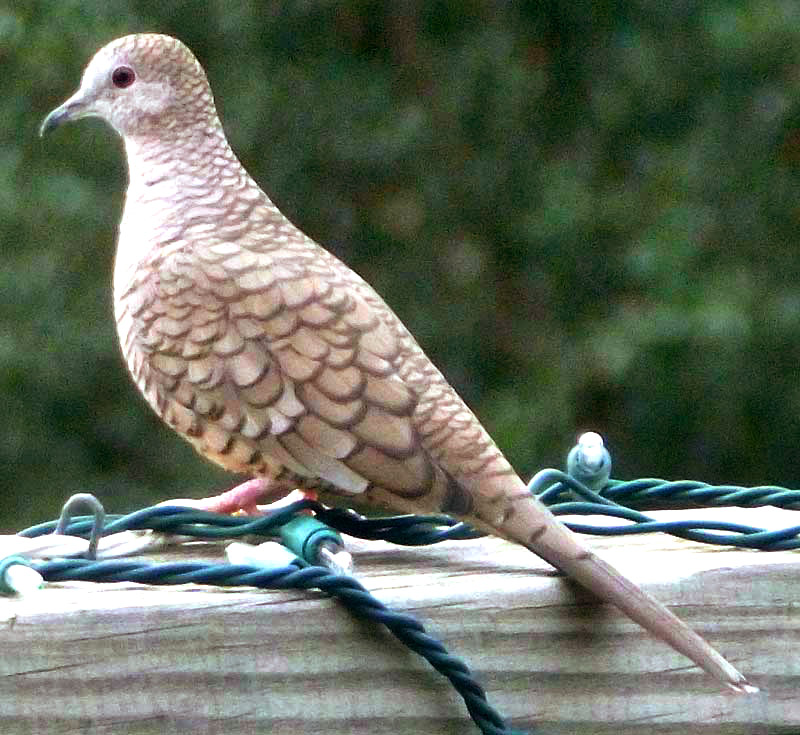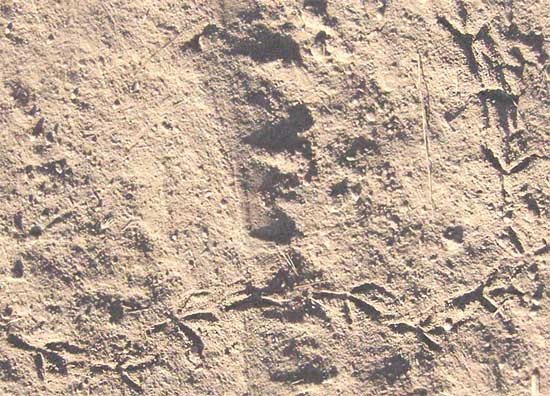Excerpts from Jim Conrad's
Naturalist Newsletter

from the November 10, 2013 Newsletter issued from the Frio Canyon Nature Education Center in the valley of the Dry Frio River in northern Uvalde County, southwestern Texas, on the southern border of the Edwards Plateau; elevation ~1750m (~5750 ft); N29.62°, W99.86°; USA
INCA DOVE
Common Ground Doves, which are small, mostly tropical American doves not found in most of North America, are commonly seen around Juniper House. At first glance they're very similar to Inca Doves, which also are small, mostly tropical American doves, and most of my neighbors call both species Inca Doves, not having noticed that two species are involved. Both species are much smaller than Mourning Doves, and the plumage of both appear "scaled." During most of the year I see no Inca Doves here, but they do come and go. I've tried to photograph them several times but failed. However, this Friday my neighbor Phred sent a picture of one visiting his birdfeeder, shown above.
How is this Inca Dove different from a Ground Dove? The Inca Dove's tail is much longer than a Ground Dove's, plus notice that the scaling effect on our Inca Dove covers the whole body, extending onto the tail. The Common Ground Dove's scaling is restricted to the head and chest area, as you can see on our pictures of him at http://www.backyardnature.net/n/b/grounddv.htm.
Inca Doves, COLUMBINA INCA, occur from Nicaragua north through Central America and Mexico into the US southwestern states -- therefore not found in the ancient Inca homeland of Perú. Inca Doves strike me as more town-oriented than Common Ground Doves, who like to hide in grasslands and small groves of trees, but do turn up below birdfeeders. In the Yucatán I had Common Ground Doves around my hut in the woods, but usually I saw Inca Doves only in people's yards in town, though sometimes they did appear on the resort's lawns near the hut.
Inca Doves are common to abundant within their range and they are expanding their distribution both north and south.
from the February 4, 2008 Newsletter issued from the Central Valley of Chiapas, MEXICO
PIGEON-TOED IN THE DUST

In late afternoon when the sun sinks low enough for it to feel a little cooler but the thermometer still reads 92°F (33.3°C), when Red-winged Blackbirds swarm across already-picked cornfields, rising into dusk's red-tinged air when you get too close, you see Inca Dove tracks wandering across the road's dust, as shown above.
Inca Doves are abundant here, always cooing whur-pu, whur-pu, and more than once when I've passed beneath a low-hanging branch a mother Inca Dove has exploded from her invisible nest so close that she ruffled the wispy fuzz atop my mostly bald head. When Inca Doves flush from the road they flash brightly rusty-red, or rufous, primaries and whirr their wings distinctively. If you don't know what an Inca Dove looks like, imagine a regular Mourning Dove, which is about 11 inches long, reduce its size to some 8.5 inches, square its long tail a bit, stain its primaries rufous, abundantly ornament it with a conspicuous, dark scaling pattern, and you pretty much have an Inca Dove. The scaling effect is so unusual that you may want to search for a picture.
Several species of small, ground-loving doves are referred to as ground-doves, and the Inca Dove is one of them. Closely related Common Ground-Doves are common here, too. They're also scaled, but not on the back, and they have much shorter tails than Inca Doves.
Did you know that the Pigeon/Dove Family is unique among birds in being able to drink by sucking up water? Birds typically fill their beaks, then raise their heads so that the water trickles down their throats.